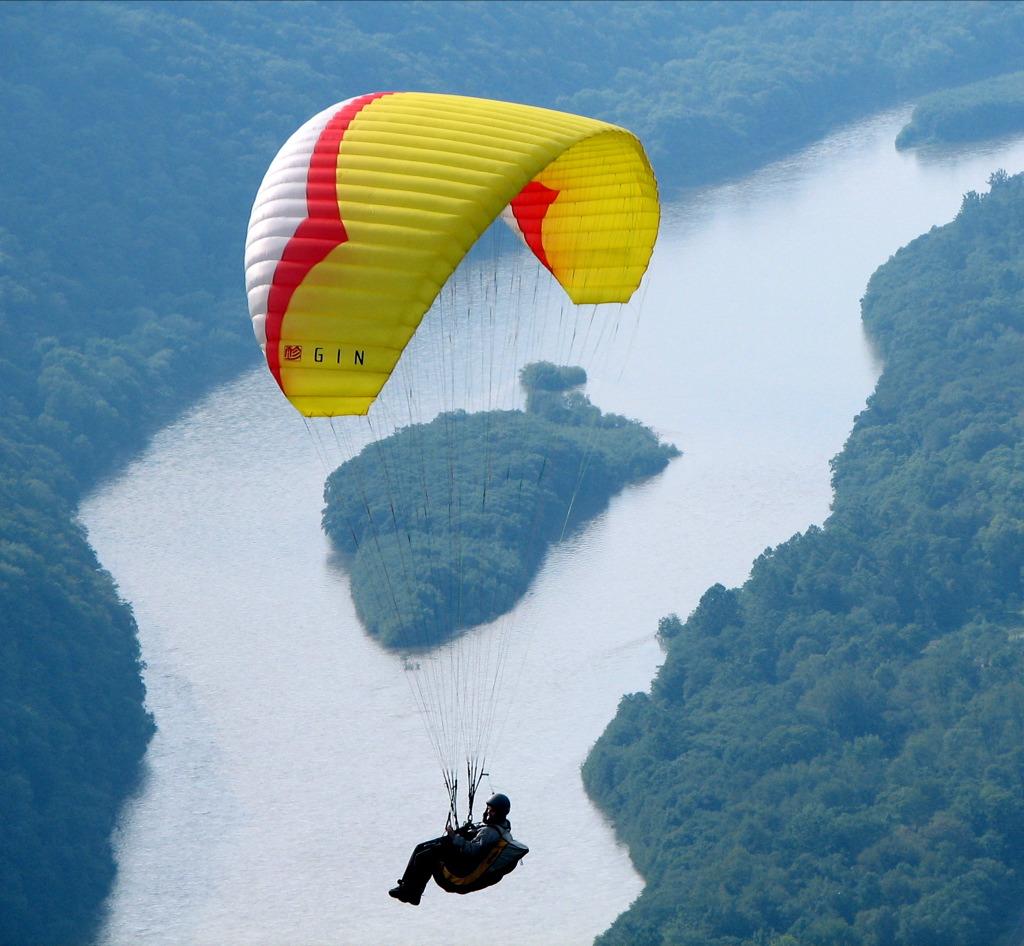Beautiful Wallpapers HD Biography
source(google.com.pk)Paragliding is the recreational and competitive adventure sport of flying paragliders: lightweight, free-flying, foot-launched glider aircraft with no rigid primary structure.The pilot sits in a harness suspended below a hollow fabric wing whose shape is formed by its suspension lines, the pressure of air entering vents in the front of the wing and the aerodynamic forces of the air flowing over the outside.
Despite not using an engine, paraglider flights can last many hours and cover many hundreds of kilometres, though flights of 1–2 hours and covering some tens of kilometres are more the norm. By skilful exploitation of sources of lift the pilot may gain height, often climbing to altitudes of a few thousand metres.
Paragliders are unique among soaring aircraft in being easily portable. The complete equipment packs into a rucksack and can be carried easily on the pilot's back, in a car, or on public transport. In comparison with other air sports this substantially simplifies travel to a suitable takeoff spot, the selection of a landing place and return travel.
Paragliding is related to the following activities:
Hang gliding is a close cousin, and hang glider and paraglider launches are often found in proximity. Despite the considerable difference in equipment the two activities offer similar pleasures and some pilots are involved in both sports.
Powered paragliding is the flying of paragliders with a small engine attached.
Speed riding or speed flying is the separate sport of flying paragliders of reduced size. These wings have increased speed, though they are not normally capable of soaring flight. The sport involves taking off on skis or on foot and swooping rapidly down in close proximity to the slope, even periodically touching it if skis are used. These smaller wings are also sometimes used where wind speeds are too high for a full-sized paraglider, although this is invariably at coastal sites where the wind is laminar and not subject to as much mechanical turbulence as inland sites.
Paragliding can be of local importance as a commercial activity. Paid accompanied tandem flights are available in many mountainous regions, both in the winter and in the summer. In addition there are many schools offering courses,and guides who lead groups of more experienced pilots exploring an area. Finally there are the manufacturers and the associated repair and after sales services.
Paraglider-like wings also find other uses, for example in ship propulsion and wind energy exploitation, and are related to some forms of power kite.In 1952 Domina Jalbert advanced governable gliding parachutes with multi-cells and controls for lateral glide.[citation needed]
In 1954, Walter Neumark predicted (in an article in Flight magazine) a time when a glider pilot would be “able to launch himself by running over the edge of a cliff or down a slope ... whether on a rock-climbing holiday in Skye or ski-ing in the Alps”.
In 1961, the French engineer Pierre Lemoigne produced improved parachute designs which led to the Para-Commander. The ‘PC’ had cutouts at the rear and sides that enabled it to be towed into the air and steered – leading to parasailing/parascending.
American Domina Jalbert invented the Parafoil which had sectioned cells in an aerofoil shape; an open leading edge and a closed trailing edge, inflated by passage through the air – the ram-air design. He filed US Patent 3131894 on January 10, 1963.
Land-based practice: Kiting
Meanwhile, David Barish was developing the Sail Wing (single-surface wing) for recovery of NASA space capsules – “slope soaring was a way of testing out ... the Sail Wing”. After tests on Hunter Mountain, New York in September 1965, he went on to promote ‘slope soaring’ as a summer activity for ski resorts (apparently without great success).
Author Walter Neumark wrote Operating Procedures for Ascending Parachutes, and he and a group of enthusiasts with a passion for tow-launching ‘PCs’ and ram-air parachutes eventually broke away from the British Parachute Association to form the British Association of Parascending Clubs (BAPC) in 1973. Authors Patrick Gilligan (Canada) and Bertrand Dubuis (Switzerland) wrote the first flight manual "The Paragliding Manual" in 1985, officially coining the word Paragliding.
These threads were pulled together in June 1978 by three friends Jean-Claude Bétemps, André Bohn and Gérard Bosson from Mieussy Haute-Savoie, France. After inspiration from an article on ‘slope soaring’ in the Parachute Manual magazine by parachutist & publisher Dan Poynter, they calculated that on a suitable slope, a ‘square’ ram-air parachute could be inflated by running down the slope; Bétemps launched from Pointe du Pertuiset, Mieussy, and flew 100 m. Bohn followed him and glided down to the football pitch in the valley 1000 metres below ‘Parapente’ (pente being French for slope) was born.
From the 1980s equipment has continued to improve and the number of paragliding pilots and established sites has continued to increase. The first Paragliding World Championship was held in Verbier, Switzerland in 1987. Europe has seen the greatest growth in paragliding, with France alone currently registering over 25,000 active pilots.
Beautiful Wallpapers HD
.jpg)
Beautiful Wallpapers HD

Beautiful Wallpapers HD

Beautiful Wallpapers HD

Beautiful Wallpapers HD

Beautiful Wallpapers HD

Beautiful Wallpapers HD

Beautiful Wallpapers HD

Beautiful Wallpapers HD

Beautiful Wallpapers HD

No comments:
Post a Comment